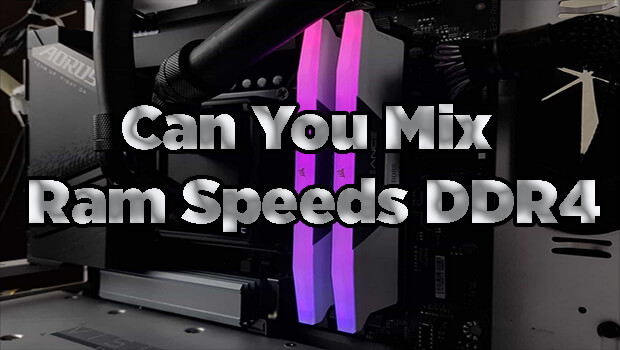Random Access Memory plays a crucial role in determining system performance. Many users often find themselves in a dilemma when it comes to upgrading or adding RAM to their systems. One common question that arises is, “Can you mix RAM speeds DDR4?”.

In this guide, we talk about the intricacies of mixing RAM speeds, exploring why it matters. How to do it, when it’s suitable, and addressing related queries like mixing RAM with different latencies. Which combines DDR3 and DDR4 RAM, and the possibility of mixing RAM from different brands with the same speed.
Why Mix RAM Speeds?
1. Performance Optimization:
Mixing RAM speeds can be a strategic move to optimize your system’s performance. In certain scenarios, it allows users to achieve a balance between cost and performance by adding modules with different speeds.
2. Utilizing Available Resources:
If you have spare RAM modules with different speeds, combining them can help maximize the available resources without the need for additional purchases.
How to Mix RAM Speeds DDR4:
1. Check Motherboard Compatibility:
Before attempting to mix RAM speeds, it’s crucial to check your motherboard’s specifications. Some motherboards may have limitations on the types of RAM they can support randomly.
2. Install Higher Speed RAM First:
For optimal performance, install the RAM module with the highest speed first. This ensures that the motherboard sets the memory speed to the highest supported frequency.
3. Enter BIOS Settings:
Access your computer’s BIOS settings to manually set the RAM speed. This step is essential for systems that do not automatically adjust to the highest speed.
When to Mix RAM Speeds:
1. Similar CAS Latency:
Mixing RAM speeds is more effective when the CAS latency (Column Address Strobe latency) is similar. This helps in minimizing potential conflicts between modules.
2. Non-Critical Applications:
If you’re primarily using your system for non-critical applications, mixing RAM speeds may not significantly impact performance. However, for tasks like video editing or gaming, uniformity is preferable.
Can You Mix RAM with Different Latency?
Mixing RAM with different latency can be done, but it’s important to understand the potential consequences. The system will likely default to the highest latency, impacting overall performance. For optimal results, aim for modules with the same or very similar latency.
a) Level of Detail:
When you mix RAM with different latencies, the memory modules will typically operate at the speed of the slowest module. This is because the memory controller has to synchronize the timings to ensure stability.
b) Preferred References:
You might find the motherboard’s manual or specifications helpful to understand how it handles mixed RAM configurations. Manufacturers often provide guidelines on compatible memory configurations.
c) Avoidance of Ambiguity:
It’s important to note that while mixing RAM with different latencies is generally possible, it might not always lead to optimal performance. It’s recommended to use RAM modules with similar specifications for the best results.
d) Promptness:
Mixing RAM with different latencies should be considered during the initial setup of your system. It’s not recommended to change RAM configurations frequently once the system is in use.
e) Problem Solving Method:
If you encounter issues or instability after mixing RAM with different latencies, consider testing each module individually to identify potential compatibility issues. Additionally, updating your motherboard’s BIOS might improve compatibility.
Can You Mix DDR3 and DDR4 RAM?
In most cases, DDR3 & DDR4 RAM are not compatible due to differences in physical design & voltage requirements. Attempting to mix them could result in damage to the components. Always consult your motherboard’s documentation to ensure compatibility.
Can You Mix RAM Brands with the Same Speed?
Mixing RAM brands with the same speed is generally possible and often works without issues. RAM modules of the same speed should be compatible with each other, regardless of the brand. The key considerations when mixing RAM are the type (DDR4), capacity, and speed.
However, keep in mind that there can be some cases where mixing RAM from different brands might lead to compatibility issues or subtle performance differences. It’s a good practice to use RAM modules with similar specifications for optimal performance and stability.
If you provide more details about your current setup and the specific RAM modules you’re considering, I can offer more tailored advice.
In conclusion, the ability to mix RAM speeds DDR4 depends on several factors. Understanding your motherboard’s compatibility, handling different latencies, and considering the implications of mixing DDR3 and DDR4 RAM are crucial aspects.
While it’s possible to mix RAM brands with the same speed, careful consideration and testing are essential to ensure stability and optimal performance. Always refer to your specific hardware documentation and, if in doubt, seek professional advice.
FAQs –
Q. Is it OK to mix RAM sizes?
Answer: It’s generally not recommended, but it can work. Matching sizes are preferable for optimal performance.
Q. Do RAM speeds have to match?
Answer: Ideally, yes. Matching speeds ensure better compatibility and performance, but it can work with mixed speeds.
Q. Can you use any DDR4 RAM together?
Answer: It’s advisable to use the same type (DDR4), but check your motherboard’s specifications for compatibility with specific modules.
Q. Can I mix RAM frequencies?
Answer: Mixing frequencies may work, but the system will likely run at the speed of the slowest module. Aim for consistency for better performance.
